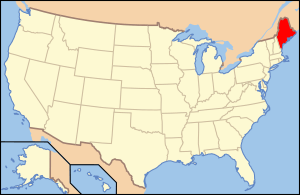Paleontology in Maine facts for kids

Paleontology in Maine is all about studying ancient life in the U.S. state of Maine. It also covers research done by people from Maine. Maine doesn't have many fossils, so its fossil record is quite rare.
Long, long ago, during a time called the Ordovician period, Maine was formed. This happened when different pieces of ancient land slowly joined together to become part of North America. Back then, Maine was covered by a deep sea. Many different kinds of creatures without backbones, called invertebrates, lived in this sea. Some of these were graptolites, which were tiny colonial animals.
Later, during the Devonian period, the land in Maine began to rise up. This was due to huge geological forces that pushed the land higher than the sea. Once Maine was dry land, some of the very first land plants started to grow and spread.
There's a big gap in Maine's rock record after the Devonian. This means we don't have many fossils from the rest of the Paleozoic, the entire Mesozoic (when dinosaurs lived!), and the early Cenozoic eras.
Much later, during the Ice Age, Maine was covered by thick sheets of glaciers or by seawater. Today, the Devonian plant called Pertica quadrifaria is Maine's official state fossil.
Ancient Maine: A Look Back in Time
Maine began to form during the Ordovician period. This was when other old land masses slowly joined with North America. At that time, Maine was covered by a sea. It was also located far to the south, in the Southern Hemisphere. Many different kinds of invertebrates lived in this ancient sea. They lived at various depths, from shallow waters to very deep parts.
Fossils of Ordovician graptolites have been found about 100 miles north of Lake Memphremagog. However, these fossils are often not very clear. It's rare to find good ones that can be collected.
Later, during the Silurian period, fossils of marine life were preserved. These are found in parts of Maine that are next to what is now New Brunswick, Canada. The fossils are kept safe in layers of sedimentary rock. These layers are mixed with other layers formed by volcanic activity, like lava and volcanic ash.
In the Devonian period, mountain building started in Maine. This caused parts of the state to rise up. By this time, Maine had dry land areas. Fossils from these land environments show us what plants grew there. These plant fossils are usually broken into small pieces. By the end of the Devonian, all of Maine was dry land.
For the rest of the Paleozoic era, the land in Maine was wearing away, not building up new layers of rock. Because of this, we don't have any fossils from that long time. This wearing away of land continued through the entire Mesozoic era. This is why no dinosaur fossils have ever been found in Maine.
The land kept wearing away from the start of the Cenozoic era until the Ice Age. About 20,000 years ago, Maine was mostly covered by huge glaciers. The incredible weight of these glaciers pushed the land down. As the glaciers melted and moved back, seawater flooded into the state. Slowly, the land rose back up to its original height. As it rose, the water drained away, and Maine became dry land again. Over time, the weather became warmer, and the plants and animals in Maine became more like what we see today.
Famous Paleontologists from Maine
Some important scientists who studied ancient life were born in Maine:
- Benjamin Franklin Mudge was born in Orrington on August 11, 1817.
- David P. Penhallow was born in Kittery Point on May 25, 1854.
- Jack Sepkoski was born in Presque Isle on July 26, 1948.
Natural History Museums in Maine
If you want to learn more about nature and fossils in Maine, you can visit these museums:
- George B. Dorr Museum of Natural History, Bar Harbor
- L.C. Bates Museum, Hinckley
- Maine State Museum, Augusta
- Northern Maine Museum of Science, Presque Isle
- The Nylander Museum, Caribou
- Wilson Museum, Castine

